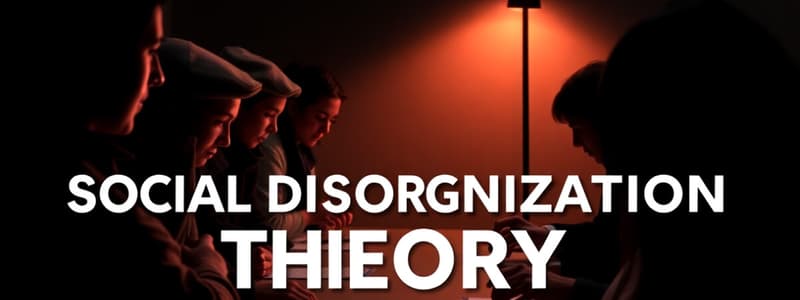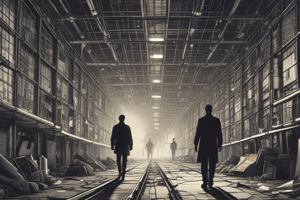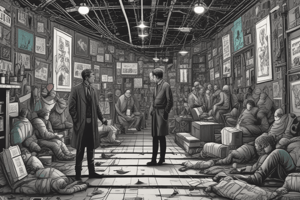Podcast
Questions and Answers
Which of the following best reflects the central argument of social disorganization theory?
Which of the following best reflects the central argument of social disorganization theory?
- Crime is a product of rational choices made by individuals seeking personal gain.
- Crime is primarily the result of individual psychological pathologies.
- Crime arises from a breakdown in social institutions and community relationships. (correct)
- Crime is solely determined by economic inequalities within a society.
In the context of the provided content, which factor most directly illustrates the 'lack of collective efficacy' in Butch's neighborhood, according to social disorganization theory?
In the context of the provided content, which factor most directly illustrates the 'lack of collective efficacy' in Butch's neighborhood, according to social disorganization theory?
- The absence of job opportunities for young adults.
- Limited access to quality education and healthcare services.
- High residential mobility and a lack of trust among residents. (correct)
- The presence of multiple families living in poverty.
How does Anomie Theory explain the occurrence of crime?
How does Anomie Theory explain the occurrence of crime?
- Crime is a way for individuals to express their conformity to societal norms.
- Crime occurs when there is a disconnect between societal goals and the legitimate means to achieve them. (correct)
- Crime is a result of the strong social bonds individuals form within their communities.
- Crime is less likely when individuals have access to illegitimate opportunities.
Which of Merton's modes of adaptation is best exemplified by Butch turning to crime as an alternative route to success?
Which of Merton's modes of adaptation is best exemplified by Butch turning to crime as an alternative route to success?
How does the content describe 'retreatism' as a mode of adaptation within Merton's strain theory?
How does the content describe 'retreatism' as a mode of adaptation within Merton's strain theory?
Within the context of subcultural theories, what is the significance of an 'alternative value system' in communities experiencing economic hardship and racial segregation?
Within the context of subcultural theories, what is the significance of an 'alternative value system' in communities experiencing economic hardship and racial segregation?
According to Cohen's theory of status frustration, how might school and family instability contribute to delinquent behavior?
According to Cohen's theory of status frustration, how might school and family instability contribute to delinquent behavior?
How does Cloward and Ohlin's differential opportunity theory extend the concept of subcultural theories?
How does Cloward and Ohlin's differential opportunity theory extend the concept of subcultural theories?
In the context of 'All God's Children', what does the analysis of Butch's life highlight regarding the causes of criminal behavior?
In the context of 'All God's Children', what does the analysis of Butch's life highlight regarding the causes of criminal behavior?
How does the conclusion of the content link Butch's experiences to his son, Willie Bosket?
How does the conclusion of the content link Butch's experiences to his son, Willie Bosket?
Flashcards
Social Disorganization Theory
Social Disorganization Theory
Crime results from the breakdown of social institutions in certain neighborhoods.
Social Disorganization in Harlem
Social Disorganization in Harlem
Harlem, in Butch's case, exhibited poverty, instability and weak social control.
Anomie/Strain Theory
Anomie/Strain Theory
Crime occurs when individuals experience a disjunction between societal goals and available means.
Blocked Opportunities
Blocked Opportunities
Signup and view all the flashcards
Innovation
Innovation
Signup and view all the flashcards
Retreatism
Retreatism
Signup and view all the flashcards
Subcultural Theories
Subcultural Theories
Signup and view all the flashcards
Harlem's subculture
Harlem's subculture
Signup and view all the flashcards
Status Frustration
Status Frustration
Signup and view all the flashcards
Differential Opportunity Theory
Differential Opportunity Theory
Signup and view all the flashcards
Study Notes
- Social structural theories provide a lens to understand how social environments shape criminal behavior.
- These theories focus on macro-level social forces, such as poverty, inequality, and social disorganization, and how they contribute to crime.
- Social disorganization theory, anomie/strain theory, and subcultural theories provide useful insights into the causes of crime.
Social Disorganization Theory (Shaw & McKay)
- This theory posits that crime stems from the breakdown of social institutions (family, schools, community) in certain neighborhoods, rather than from individual pathology.
- Harlem was marked by poverty, instability, and weak social control, aligning with the characteristics of high-crime areas.
- Family breakdown occurred when Butch's mother struggled with an abusive partner and multiple children, hindering her ability to provide emotional and financial support.
- This lack of parental supervision led Butch to spend time on the streets, reinforcing criminal behaviors.
- Harlem became a segregated, poverty-stricken area with little community cohesion.
- Communities with high residential mobility, poverty, and a lack of collective efficacy struggle to regulate delinquent behavior.
- Schools failed to engage Butch, and the legal system cycled him through institutions, reflecting the inability of social services to provide support.
Anomie and Strain Theory (Merton, Cohen, Cloward & Ohlin)
- Anomie theory suggests that crime occurs when individuals experience a disjunction between societal goals and the means to achieve them.
- Butch's grandmother promised him a life in Harlem-economic success, security, and social mobility.
- Harley did not grant him these opportunities, creating a stain between aspiration and reality.
- Merton's strain theory suggests that individuals adapt to strain in different ways.
- Some individuals turn to crime as an alternative route to reaching social goals.
- When conventional means and criminal opportunities become unavailable, some individuals "drop out"
- Butch sleeping in the subway and shelters can be seen as rejecting both legitimate and illegitimate paths.
Subcultural Theories (Miller, Cohen, Cloward & Ohlin)
- Subcultural theories argue that delinquency arises from youth subcultures that develop in response to mainstream societal rejection.
- Harlem's history of economic hardship and racial segregation produced an alternative value system.
- In this value system respect, toughness, and survival on the streets were more important than traditional success.
- Status frustration occurred when Butch struggled with school and family instability, likely leading to feelings of rejection and inadequacy.
- Instead of succeeding through conventional means, he adopted skipping school and manipulating police to gain a sense of agency and identity.
- Individuals in disorganized areas often turn to gangs when legal opportunities are blocked.
Conclusion
- Butch's life trajectory was shaped by structural, disadvantages, community instability, and a deep-rooted culture of violence.
- His experiences reflect a systemic failure where societal conditions contributed to his criminal path.
- These same structural forces influenced is son, Willie Bosket, illustrating intergenerational transmission of crime and violence.
Studying That Suits You
Use AI to generate personalized quizzes and flashcards to suit your learning preferences.




